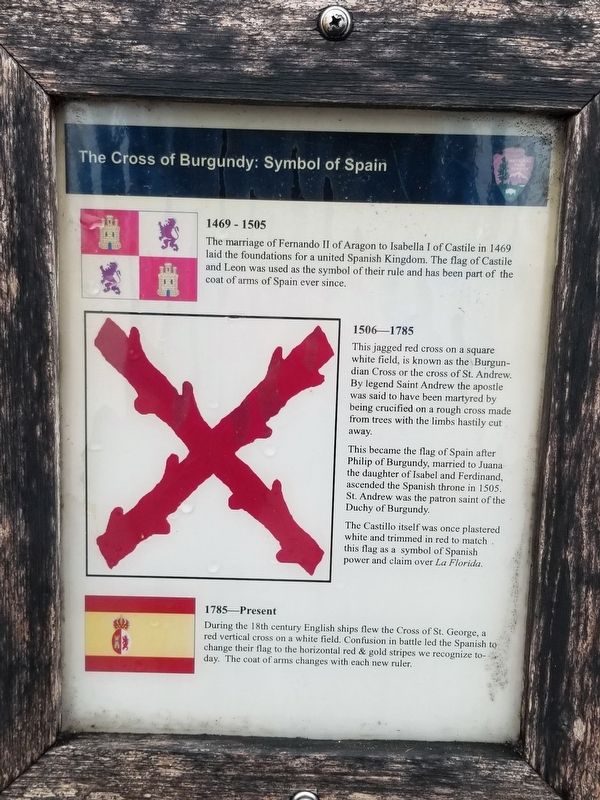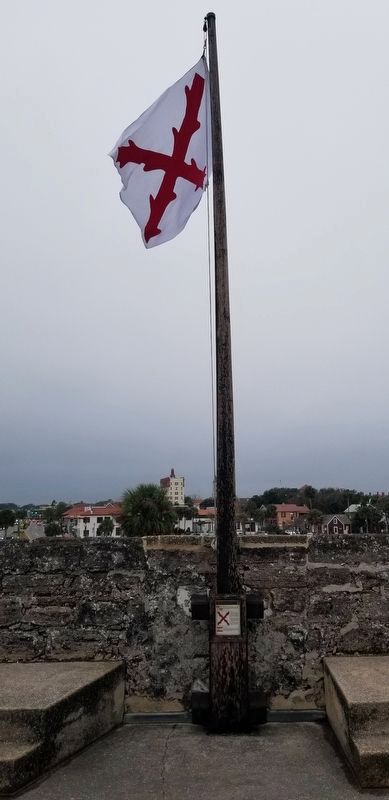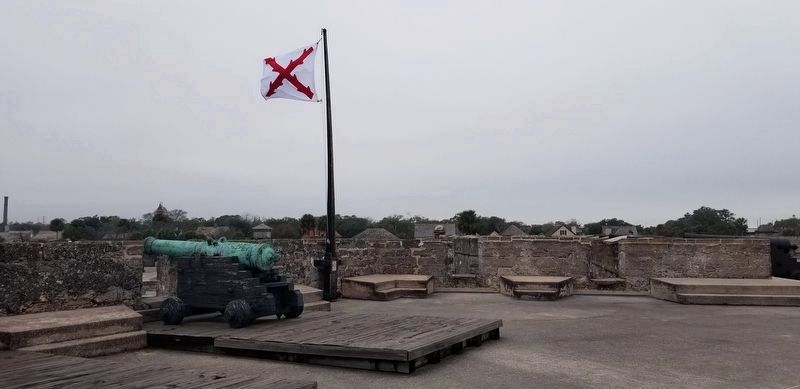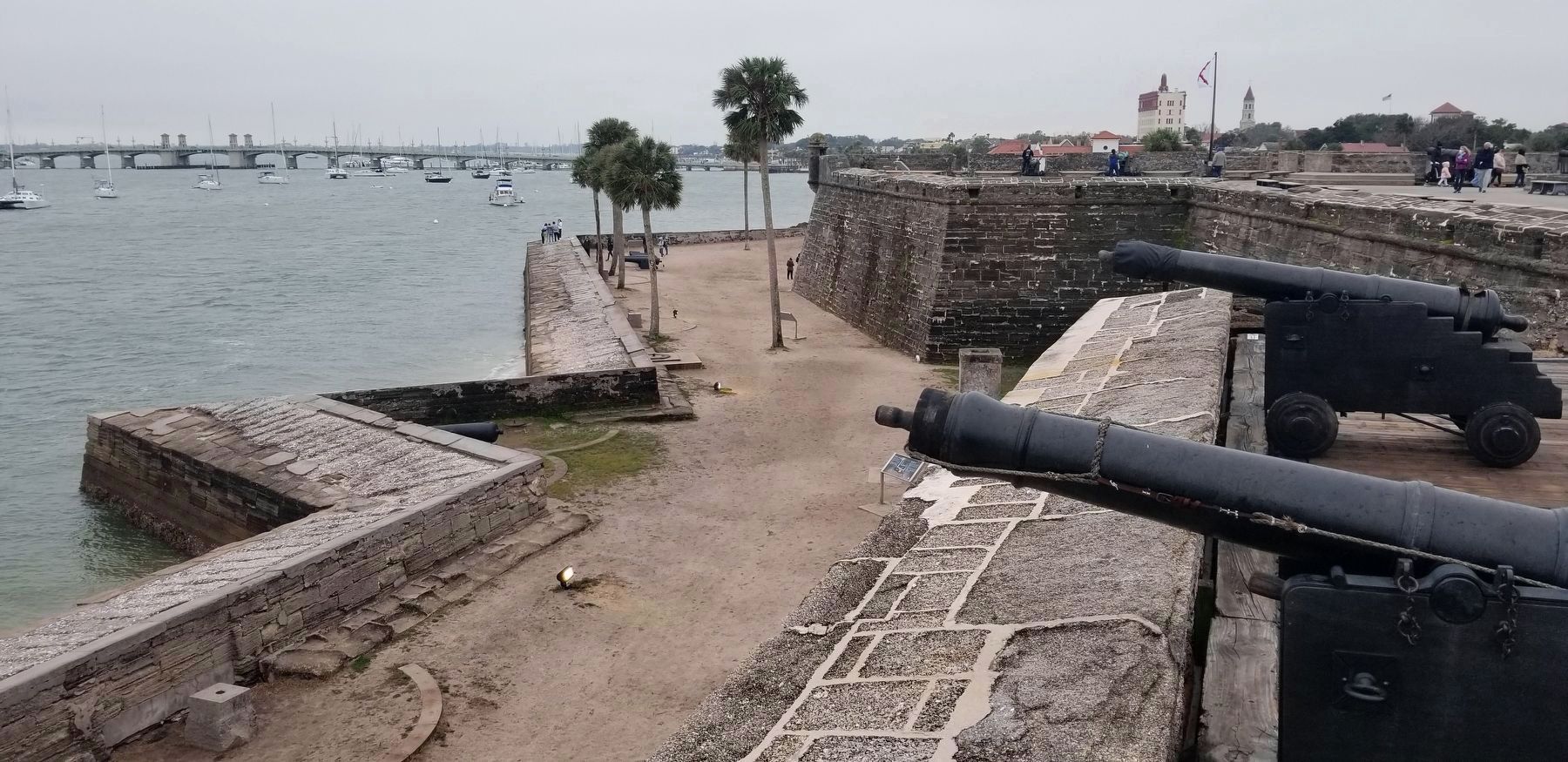St. Augustine in St. Johns County, Florida — The American South (South Atlantic)
The Cross of Burgundy: Symbol of Spain
The marriage of Fernando II of Aragon to Isabella I of Castile in 1469 laid the foundations for a united Spanish Kingdom. The flag of Castile and Leon was used as the symbol of their rule and has been part of the coat of arms of Spain ever since.
1506-1785
This jagged red cross on a square white field, is known as the Burgundian Cross or the cross of St. Andrew. By legend Saint Andrew the apostle was said to have been martyred by being crucified on a rough cross made from trees with the limbs hastily cut away.
This became the flag of Spain after Philip of Burgundy, married to Juana the daughter of Isabel and Ferdinand, ascended the Spanish throne in 1505. St. Andrew was the patron saint of the Duchy of Burgundy.
The Castillo itself was once plastered white and trimmed in red to match this flag as a symbol of Spanish power and claim over La Florida.
1785 Present
During the 18th century English ships flew the Cross of George, a red vertical cross on a white field. Confusion in battle led the Spanish to change their flag to the horizontal red & gold stripes we recognize to day. The coat of arms changes with each new ruler.
Erected by Castillo de San Marcos National Monument - National Park Service .
Topics. This historical marker is listed in these topic lists: Colonial Era • Forts and Castles • Hispanic Americans. A significant historical year for this entry is 1469.
Location. 29° 53.855′ N, 81° 18.676′ W. Marker is in St. Augustine, Florida, in St. Johns County. Marker can be reached from the intersection of South Castillo Drive (Florida Route A1A) and Orange Street. The marker is located at the southeastern corner of the Castillo de San Marcos. Touch for map. Marker is at or near this postal address: 1 South Castillo Drive, Saint Augustine FL 32084, United States of America. Touch for directions.
Other nearby markers. At least 8 other markers are within walking distance of this marker. St. Augustine's Bastion (here, next to this marker); Firing Steps (a few steps from this marker); Guarding the Back Door / Vigilando dos entradas (a few steps from this marker); Pirate Attacks (a few steps from this marker); Tidal Toilet / Limpiado por las mareas (a few steps from this marker); Sentry Box (a few steps from this marker); Fortress Facelift / Nuevo dueño, obras nuevas (a few steps from this marker); Ramp (within shouting distance of this marker). Touch for a list and map of all markers in St. Augustine.
More about this marker. The marker is located on the inside section of the Castillo de San Marcos National Monument. There is a small entry fee
required to visit the monument.
Also see . . . Cross of Burgundy.
The Cross of Burgundy (French: Croix de Bourgogne; Spanish: Cruz de Borgoña/Aspa de Borgoña; German: Burgunderkreuz) is a saw-toothed (raguly) form of the Cross of Saint Andrew. It was first used in the 15th century as an emblem by the Valois Dukes of Burgundy, who ruled a large part of eastern France and the Low Countries as an effectively independent state. The Burgundian Low Countries were inherited by the Habsburgs, who adopted the flag at the extinction of the Valois ducal line and continued to use it as one of their many symbols up to the 18th century. With the Burgundian Habsburgs coming to power in Spain in the 16th century, the emblem served as a naval ensign of the Spanish Empire up to 1701, and up to 1843 as the land battle flag, acquiring a global impact throughout Europe and the Americas in the possessions of the Spanish crowns of Castile and Aragon. It is found nowadays in different continents and still appears on regimental colours, badges, shoulder patches and company guidons. The use of the emblem in a variety of contexts, in a number of European countries and in the Americas, reflects the historical extent of Burgundian, Habsburg, and Spanish territories. Source: Wikipedia(Submitted on February 4, 2022, by James Hulse of Medina, Texas.)
Credits. This page was last revised on February 4, 2022. It was originally submitted on February 4, 2022, by James Hulse of Medina, Texas. This page has been viewed 1,166 times since then and 242 times this year. Photos: 1, 2, 3, 4. submitted on February 4, 2022, by James Hulse of Medina, Texas.



